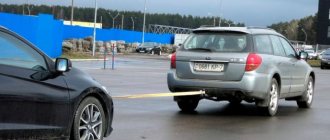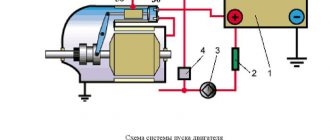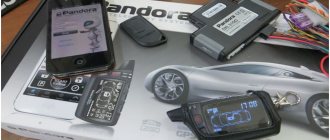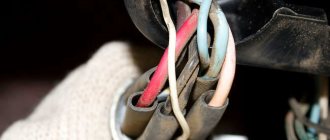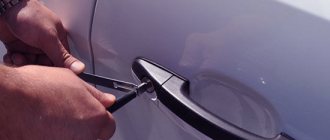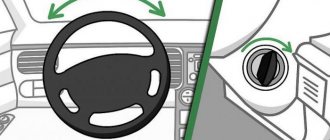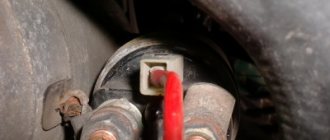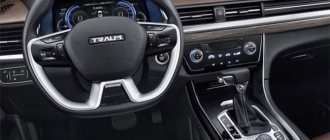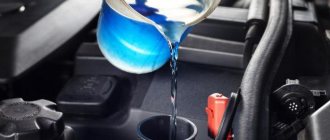Many car owners are faced with the problem of a starter breakdown at the most inopportune moment, when they have to call a tow truck to the nearest service center. There are several ways to start a car without a starter - it is important to understand the principle of operation of the ignition system and the structure of the transmission.
To ensure the ignition cycle of the fuel mixture in the cylinders and the activation of the generator, a primary revolution of the crankshaft flywheel is required with the electrical circuit running.
For a manual transmission, solving this problem is simple - the engine is started from a pusher or in tow; in units with an automatic transmission, a direct start is required by closing the starter contacts, or by using the compressor pulley. This is due to the fact that in cars with automatic transmission, torque from the engine to the wheels is transmitted through a torque converter: forced start and engagement of automatic transmission requires high acceleration speed when the box is warm. Attempts to start the engine with an automatic transmission in tow can lead to jamming, damage to satellites and gears, or failure of the valve system.
What should be done
First check the connection between the battery and starter.
After this, it is advisable to turn on the headlights or turn on the signal. Dim light and a quiet signal means the battery is low. Make sure that they are working properly - disconnect the wires from the ignition switch (30 and 50) and short-circuit them for a short time. The starter has started, which means the ignition switch is faulty. In this case, the engine was started, the wires were put in place and we drove on. The battery is fully charged, but the starter does not turn. The reason is bad oxidized contacts; first of all, you need to check the negative wire. It needs to be cleaned, and the battery terminals should be washed with a soda solution and lubricated with grease or added motor oil.
If the ignition switch is working properly, you need to briefly connect an additional wire to the output of the traction relay and touch the positive terminal of the battery with it. Triggering of the starter indicates a fault in the electrical circuit.
It was not possible to start, use a tow and go to a service station to repair the starter.
Cases in which the problem can be solved on site
If the starter does not turn, there are several ways to start the car:
- close the starter contacts with a screwdriver;
- Connect the starter directly to the battery.
In an automobile system, the starter has a separate role - to spin the crankshaft to create the required torque and compression ratio for the fuel-air mixture. Naturally, the starter functions in conjunction with other components and electrical systems. Therefore, damage of various properties may occur:
- lack of voltage in the on-board network;
- battery discharge;
- damage to wires;
- problem in the ignition switch;
- mismatch of oil viscosity in the crankcase;
- weakening of contacts.
If the starter does not work, then in most cases the traction relay fails, the coil winding burns out, the bendix slips, or the screw thread drive runs slowly.
Some damage to the starter allows it to operate normally when the engine is running. But he fails to spin the heavy flywheel the first time. In any case, after a successful start, it is necessary to urgently take the starter for professional diagnostics in order to identify the true cause of the malfunction.
Thus, a malfunction of the starter can be caused by:
- faulty start relay;
- Bendix wear;
- problems with the solenoid relay;
- combustion of the internal elements of the unit.
Signs of a faulty starter
1. With a fully charged battery, a faulty starter causes a voltage drop to 9V.
2. When starting the engine, a clear click is heard, but the starter itself does not turn the engine.
Basic starter malfunctions
There may be several reasons why the starter cannot be started:
· Faulty starter retractor relay;
· The Bendix is out of order, what is its wear: the gear turns, the connection between the starter and the engine flywheel is missing;
How can you start a car without a starter?
You can start the car with a pushrod. However, remember that this method works without damage to the car only for cars with a manual transmission. The procedure is as follows:
· The lever is placed in first gear;
· The vehicle begins to accelerate, the higher the speed of the towing vehicle, the faster the engine will start;
· In the absence of a towing vehicle or assistants pushing the car, you can start it by first placing it downhill.
Starting the engine using the wheel, it is only suitable for cars with front-wheel drive.
1. The wheel must be turned so that it is convenient to turn.
2. Place a jack under it.
4. Move the lever to third gear.
5. Start spinning the wheel. This can be done using a tow rope, rope, or even a wheel wrench.
Starting the engine using a crooked starter. It can only be used for cars of old Soviet models.
Features of forced start of a car with automatic transmission
In some cases, you can try to force the crankshaft of the car to rotate. Conditions for starting a car with automatic transmission. The lever should be in the “D” Drive position. The speed must be more than 30 km/h. Remember that this method is best used as a last resort.
Important. A vehicle with an automatic transmission must not be pushed or towed. The reason is as follows:
1.
Unlike manual transmission cars, there is no rigid connection between the wheels and the engine.
2.
Communication occurs only through the torque converter; without the engine, the automatic transmission pump will not work, and the gear will not engage.
3.
An attempt to carry out such a launch is fraught with failure of the valves or jamming of the box.
The cause of a starter malfunction may be due to surprises in some security systems.
It lies in the self-starting alarm and in the problems of the standard immobilizer of some foreign cars. For example, Ford Focus2. Even though the starter was in full working order, it refused to work. The reason is identified in the following way: power from the battery must be supplied to the starter directly, bypassing the security system. Such cases are rare, but they do happen.
If the starter malfunction occurs on a long journey
To protect yourself on a long journey, take a spare unit. This is especially true for some starters of expensive foreign cars, which are rare and difficult to find in warehouses and workshops.
The starter broke down on the road, you decided to call an emergency auto electrician. Remember that when repairing the starter yourself, you must take into account the type of starter, the manufacturer and the technical parameters of the unit.
If it is impossible to replace the starter yourself and move independently, there is no one to come to the rescue - call a tow truck.
Clutch lock or rigid coupling
ATTENTION! A completely simple way to reduce fuel consumption has been found! Don't believe me? An auto mechanic with 15 years of experience also didn’t believe it until he tried it. And now he saves 35,000 rubles a year on gasoline! Read more"
Interesting thing. It turns out that in the manuals of modern foreign cars with automatic transmissions it is written in black and white: blocking the clutch will ensure the ability to transfer the transmission from the crank shaft directly to the automatic shaft. In other words, the car can be started without a starter, although its speed must be above 70 km/h, and the temperature of the ATF box must be at least plus 50 degrees Celsius. It turns out that you can start it from the pushrod by preheating the fluid? This will lead to blocking of the clutch after switching the automatic mode to D. The wheels themselves will begin to turn the engine, as usually happens when starting a car from a pusher.
Theoretically, the essence of the operation comes down to ensuring continuous rotation of the car’s wheels. The CM (torque of rotation) formed in this way must be transferred to the gearbox, that is, the transmission, and then to the crank shaft of the engine. This will start the engine, because a cycle will start in the combustion chamber. And the starter, as we see, is out of work here.
Advantages
Rarely and only in some workshops there is a service for replacing absolutely any starter model. One of such campaigns is auto repair shops at their service, several specialized wholesale warehouses in Lyubertsy, Zheleznodorozhny and Moscow.
If necessary, having encountered a malfunction of a rare starter of a foreign passenger car or special equipment, the client can contact the auto repair shop and order starter repair.
guarantees the completion of any most complex repairs.
Source
Starting a car without a starter: is it possible?
Many motorists have at least once found themselves in a situation where a car starter stubbornly refused to fulfill its main purpose. And everything would not be so sad, but such situations always happen at the most unexpected and inopportune moment. If you need to go immediately, but time is running out, this can become a real problem and a reason for a breakdown. Fortunately, there is a way out of this situation. You just need to start the vehicle without a starter or close it directly. How to do both will be discussed in more detail within the framework of this useful material.
What must be done before closing the starter?
Few people know, but before taking more drastic measures, motorists must perform diagnostics. For what? It would be a good idea to understand, before performing any work, what is causing the failure of the starter and what could be wrong with it. Sometimes problems with the starter can be fixed on the spot yourself. However, if serious problems arise with the starter, such as a malfunction of its relay or a breakdown of the solenoid relay, severe wear of the bendix or a burnt winding, then you can immediately begin to look for a way to start the car engine using another method. And although there are not many such methods for starting a motor with a non-working starter, they still work and without fail.
Methods for starting an engine without a starter
One of the easiest ways to start a motor without a starter is considered to be the old-fashioned method. It will require the help of a couple of people. They must press their hands firmly into the trunk of the car and, on command, begin to accelerate it. At this time, the driver in the car must turn on the ignition switch and first gear. The engine will start faster if the car accelerates faster. This launch method is popularly called “pusher launch”. The second way to revive the engine is to use towing. A car with a faulty starter must be towed by another vehicle using a cable at a certain distance. The work must be carried out very carefully, since the moment the towed car starts, it will begin to accelerate, and it is also worth considering that when the car in front stops, the car following it must also be stopped.
How to close the starter?
There is another way to bring a car back to life, which does not involve the use of brute physical force. To close the starter directly, you need to acquire a special tool. To do this you need a screwdriver, a wrench, and a pry bar. To do this, you first need to set the gearshift lever to neutral and tighten the brake all the way. Place the key in the lock in the appropriate position so that the solenoid relay operates. Make sure that when starting the starter directly on the contact ignition system, the coil does not fail.
More information about starting the engine without a starter will be discussed in this video:
Source
We are trying to make a “friend” without his “atrium”
TIP - before closing the starter, it is advisable to inspect it and make a diagnosis.
Initially, it would be good to try to find out the reasons for the failure of the starter - what if you are lucky and the problems associated with its failure can be eliminated yourself.
The most common breakdowns are the following:
- Starter relay failure.
- The solenoid relay does not operate fully.
- Severe wear on the teeth of the Bendix gear, namely, the gear rotates, but does not engage with the teeth of the engine flywheel ring.
- The stator winding in the starter burned out.
So, let’s start the “heart” of the car.
Method 1, or how to start a car from a push, or “from a pusher”?
Everything is quite simple, but at the same time very reliable. Its essence is that the driver needs to find at least a couple of people, let them be, for example, neighbors in a garage cooperative who sympathize with him. And they don’t need to be of strong build, the main thing here is the number of participants: the more, the better. The entire team (company) rests their hands on the trunk, rear pillars, etc., and begins to push the car, accelerating it. The driver, in turn, sitting behind the wheel, already with the ignition on and, better yet, with third gear engaged, as well as with the clutch depressed, after waiting for the car to accelerate, the clutch is already released. After this, the engine “sneezes” and starts. The higher the acceleration speed, the faster the engine will start.
Method 2 Also effective and popular among drivers. This auto-folk method of starting a car without a starter is called “towing” - this is when your iron friend is pulled by another vehicle on a tow rope until the engine starts.
With this method, it is important to remember that after starting the engine, the car will begin to accelerate and you must immediately depress the clutch and turn off the gear, but, of course, do not turn off the engine!
In addition, do not forget to press the brake so as not to hit the car pulling you in the rear and put your car on the handbrake, and after that you can go and unhook the cable.
Method three, or we start the engine by simply closing the starter.
In addition to the above options, the engine can be started without “violent” methods. Just need to have at least a little idea of how to close the starter directly?
Often, drivers close the starter using everything that is at hand in the car. This could be a screwdriver, a spatula, a wrench, etc.
TIP - a screwdriver will be effective if the starter relay is faulty.
This is easily recognized by the characteristic clicks coming from the engine compartment when starting the engine. This sound tells the driver: “Hey, friend, the relay is on, but the Bendix gear is not able to turn the engine crankshaft.” There is only one way out - you bridge the starter, and with this action you apply voltage to the winding.
In this case, you will need a large screwdriver, but you can use any open-end wrench. Any of these items must close the terminals of the solenoid relay and that’s it. But, do not forget, before closing the starter directly, you must:
- The ignition key must be placed in the appropriate position.
- The gear lever must be in neutral.
- The car must be put on the handbrake.
Read also: Factory-made methane cars
With this method, a screwdriver (wrench) plays the role of a solenoid relay and the engine of your car must start.
Many car owners are faced with the problem of a starter breakdown at the most inopportune moment, when they have to call a tow truck to the nearest service center. There are several ways to start a car without a starter - it is important to understand the principle of operation of the ignition system and the structure of the transmission.
To ensure the ignition cycle of the fuel mixture in the cylinders and the activation of the generator, a primary revolution of the crankshaft flywheel is required with the electrical circuit running.
For a manual transmission, solving this problem is simple - the engine is started from a pusher or in tow; in units with an automatic transmission, a direct start is required by closing the starter contacts, or by using the compressor pulley. This is due to the fact that in cars with automatic transmission, torque from the engine to the wheels is transmitted through a torque converter: forced start and engagement of automatic transmission requires high acceleration speed when the box is warm. Attempts to start the engine with an automatic transmission in tow can lead to jamming, damage to satellites and gears, or failure of the valve system.
Will the car start without a push starter?
TO
Every car owner sooner or later faces a problem when he cannot start his car using the usual method. This happens especially often in winter. Many experienced drivers know that starting is possible from the so-called “pusher”, when the car is either pushed or pulled on a cable or belt by another car. All these methods easily started older carburetor types of cars (they were generally less demanding), because they had a minimum of electronics. But injection cars are a completely different topic, they have a lot of microcircuits, just remember the ECU that controls everything! A fair question arises - is it possible to start an injector engine from a pusher? Let's find out...
— Starting the car from the pushrod may only be necessary if it needs to be done without using the starter, due to, say, a low battery charge.
Push start with injector? - Can
As stated above, if the car has a carburetor, then no questions arise - it can be started in a similar way. But is it possible to start an injection car with a pusher?
The answer to this question is simple - it is possible, but in this situation you should understand that you can encounter some additional problems.
When starting an injection engine from a tug, the entire sequence of actions looks the same as in the case of a carburetor:
The ignition is turned on; The clutch pedal is depressed, the gearbox is put in high gear; When the car reaches a speed of up to 10 - 20 km/h, the clutch pedal is smoothly released, and the accelerator is pressed at the moment the gearbox is connected to the engine. But when using this starting method, you need to remember that injection vehicles are equipped with an electronic fuel pump. Therefore, the gas pedal must not be pumped until the engine is fully operational. After starting the engine and stopping the car, you should increase the speed slightly.
It is also important to remember that, unlike cars with a carburetor engine, which can be started even if the battery is completely empty, when towing an injector, the battery must have at least a small level of charge in order to power the main engine control systems.
Features of starting an injector from a pusher
TO
As has already been noted, injection cars can be started from a pusher. But it should be remembered that such engines are more sensitive compared to carburetors, so when using this starting method, there is a possibility of damaging some components of the unit.
Thus, during the “starting” process, the load on the gas distribution mechanism of an injection-type engine increases significantly compared to those generated by the starter. This can lead to damage to the unit or its complete failure.
If there is a need to start the power unit while towing, then it is best to do this in high gears - 3 or 4.
Typically, 8-valve engines start working from a tug without any problems - they also have much fewer cases of breakdowns, yet the design is much simpler.
It is not recommended to start a 16-valve injector using this method, as there is a possibility of failure of the catalyst or converter. In some cases, the piston may even collide with the valves.
When should you not start the pusher engine?
You cannot start the injector when towing if there is no voltage in the on-board network. In this case, the increased voltage that occurs after the power unit starts operating from its generator can damage all electronics.
For the same reason, it is not recommended to start the power unit using a donor car.
In simple words, the battery must be in the car, and it must have a voltage, albeit not very high.
Types of automatic transmissions
At the moment, there are three types of automatic transmissions:
- Automatic hydraulic box. It completely separates the engine and wheels. They are not directly connected to each other, but the torque is transmitted through turbines through a special fluid. Modern boxes are additionally equipped with electronic devices that allow you to set different operating modes. It is also possible to simulate manual gear shifting, although it will be generally controlled by the automatic transmission;
- Robotic mechanics. This gearbox is not very popular among drivers. It is mainly adapted for a calm and smooth ride, but it is much more difficult to cope with acceleration. In terms of the type of control, this is an ordinary automatic machine that has nothing to do with mechanics. A regular robot is equipped with one clutch, which is not enough for smooth gear changes. There is often a feeling of a “thrown clutch” when accelerating. The car seems to be frantically jumping through the gears and does not have time to work through them to the end, which is why slight “jabs” occur. Recently, a robot with two clutches has been developed (for example, DSG for Volkswagen and DCT for BMW). Here things are much better and the car copes with acceleration, but the service life of such a transmission is so unpredictable and often short that there is even an official petition of many thousands from the owners of such “experiments” demanding a free DSG replacement even after the warranty expires. Moreover, in Europe, a similar complaint was considered and fulfilled, agreeing with the imperfection of the automatic transmission, but in Russia, manufacturers are not yet in a hurry to admit the low reliability of the robot;
When do we need to start a car without a starter?
If the car refuses to start in the garage, then we can try to identify and fix these problems here. But there are cases when the car refuses to start after stopping somewhere on the highway far from home. Or you need to go urgently and identify the preconditions, much less eliminate them, there is no time. Then we start the car without a starter. Also read the article about how to drive a car when the battery is low. This can be done in several ways.
How can you start a car without a starter?
First, charge the battery thoroughly, in case there is still a problem with it. In the last article we wrote about the main reasons why a car won’t start. If the car still won’t start, let’s try to start it
it from the pusher. This is the most effective and most often used method in our area. You are unlikely to cope with this task alone. You need to ask a couple of people to help you in this difficult task. You turn on the ignition and first gear, and your volunteer assistants push
car
, leaning on the trunk and trying to speed up the pace. The faster they move, the faster your car will start.
I pushed it myself - I started it myself
Anyone who has driven with a weak battery knows: you need to leave the car on a hill, from which you can roll down and start it “from the pusher”. But is a very low speed enough if the road has almost no slope and you accelerate the car yourself?
The operating principle is as follows: turn on the ignition, put the transmission in neutral, manually accelerate the car, jump in, squeeze the clutch, engage the gear, release the clutch...
On a very flat section, the speed is still not enough. You can, of course, try to overclock it - the machine is light. I'm strong - can I handle it? I'm smart: there's still an easy descent ahead. For the purity of the experiment, I simply won’t accelerate the car too much, I’ll try at minimum speed,” says the author of the experiment.
It doesn't work in second gear - it's too slow. Well, then the first one - and the car starts. I do the same trick in reverse gear, rolling the car back. This is about the fact that you can push in any direction depending on where the descent goes.
As experience shows, not every car can start like that, with half a turn - it all depends on the design features and the condition of the engine. And even more so, this applies to cases when, in the same winter, the engine is, in principle, reluctant to start. And in this case, you cannot do without the help of a friend. Or is it still possible?
Car towed
You can also ask a driver passing by to take you in tow. To do this, attach your car
with a cable to tow the assistant to the car, while sitting behind the wheel, turn on the ignition and first gear. As soon as your car starts working, give a sign to the assistant and stop your car.
If you do not drive the assistant into the rear bumper, stop your car in time. Then you need to disconnect the cable and thank the kind person for the help provided. The most important thing is not to forget about your problem and do not accidentally turn off the engine when you have to stop and get out of the car, otherwise you will need to push or tow again. Don’t forget about this.
Undesirable consequences
After an extreme start of the car, undesirable consequences may appear:
- Stopping the engine while the vehicle is moving will result in a significant reduction in braking.
- Braking and stopping the car now requires more effort.
- A significant reduction can also be seen in the power steering function.
- The steering system is not locked, but maneuvering will now require more effort when the ignition is turned off.
- Some electrical circuits, including the airbags, also turn off.
If the ignition was turned off unintentionally, you can shift to the neutral (N) position and restart the engine.
Starting the engine without a starter with a manual transmission
- Turn on the ignition with power consumers turned off (headlights, side lights, audio system, alarm, air conditioning).
- The car is accelerated from a pusher with the help of assistants, or in tow and engaged in first gear - the higher the acceleration speed, the faster the engine will start. Diesel units are started by engaging second gear. In the absence of assistants, you can start the car down the slope yourself.
The engine on a front-wheel drive car can be started using the front wheel:
- Place the front part of the car on a jack, giving free play to the front wheels.
- Turn on the ignition.
- The gear lever is set to third speed.
- They begin to rotate the front wheel in the direction of travel. As a material at hand, use a tow rope, wrapping it around the wheel, or use a regular wheel wrench.
What to do if the starter turns, but the car does not start
In cars with a key ignition, you can use the universal method of starting the engine. If you cannot start the engine after 3 attempts, you need to wait 1-2 minutes.
Next we proceed in the following way:
- Press the brake pedal all the way.
- Turn on the parking brake.
- Move to parking position (P).
- Fully press and hold the accelerator pedal.
- Turn the ignition to position III.
- We are waiting for the engine to stop.
- Release the accelerator pedal.
- Let's start the engine.
Starting an engine without a starter with an automatic transmission using the short-circuit method
To properly start the engine by closing the starter on cars with an automatic transmission, it is necessary to take into account the electrical diagram of the connections of its components. A typical mistake made by motorists when trying to close the starter is to bridge the two output terminals of the contacts with a screwdriver. In this case, the electric motor is activated, but the traction relay remains disconnected and the overrunning clutch is not connected. It is not recommended to directly close the starter power terminals.
Any starter has three positive contacts “B”, “M”, “S” and one negative - 8, which is always connected to the housing. Terminal "B" is always under DC voltage from the battery. Procedure:
- Before closing the contacts, you need to find the “S” terminal. On modern starters it looks like a protective casing-petal.
- Carefully observe the difference between contacts “B” and “M” - the permanently connected “B” is marked “+12”.
- To start the starter, contact “B” and terminal “S” are closed.
- The short circuit occurs briefly and only after connecting the “neutral”.
- It is forbidden to close contacts “B” and “M”!
On domestically produced cars, it is easy to find the necessary starter terminals: for example, a traction relay with contact designations on a VAZ 2114 looks like this:
Output contact “B” here is covered with a rubber protective casing, and the traction relay terminal “S” is located under a plastic plug, which must be removed before closing.
The contact is closed with a screwdriver when the ignition is connected:
Important: when closing, make sure that the screwdriver does not touch the body of the solenoid relay, otherwise “+” and “ground” will be shorted!
On foreign cars with automatic transmission, the “S” terminal looks different: it is often made in the form of a threaded terminal with a copper tip and white wire insulation. It is convenient to close such a contact with an open-end wrench:
When closing contacts, observe safety precautions: the traction relay of a car at idle speed consumes from 30 to 100 A, and the starting current can reach up to 600 A. You must work with insulating gloves; if the screwdriver or key “sticks”, you should immediately remove the minus terminal from battery. The 12 V starter operating voltage is not dangerous, but errors can burn fuses or wiring.
conclusions
Let's look at diagram 1 again. If the key is not turned to the Start label, terminal S is “hanging in the air.” This can be done for any car, even if the circuit has an additional relay. This means that it will not be necessary to disconnect the standard wire from terminal S... And in the case of a VAZ, the disconnection is carried out in order to gain access to the terminal.
We removed the filter, disconnected the plug, and tried to close it...
If the engine filter cannot be removed or access is blocked by the battery, we do it differently - we use only the crank.
It is better to close the contacts not with a screwdriver, but with any wrench (see photo). It is desirable that the handle be insulated.
12 Volt voltage is not dangerous, but errors can result in blown fuses. Good luck.
For those who do not understand everything: the filter must be removed from the mounts, but not from the “corrugation”. The filter housing is placed on the battery.
Starting an engine without a starter with an automatic transmission using a compressor pulley drive
This method is not suitable for all cars, but only for those where open access to the compressor drive unit is possible. To start, you will need a strong rope with a diameter of 5-7 mm and a strong round stick about one meter in size (you can use a simple shovel handle). The essence of the start is the transmission of torque from the air conditioning compressor pulley to the crankshaft flywheel.
- The standard drive belt on the compressor pulley is removed.
- One end of the rope is wound around the crankshaft flywheel.
- The second end is through a prepared stick, which is mounted horizontally on the engine, onto the compressor pulley.
- Turn on the ignition simultaneously with the air conditioning.
The power of the switched on compressor is usually enough to crank the engine crankshaft and trigger sparking.
Often the cause of a starter failure can be diagnosed on site and the problem can be repaired. The most common malfunction in the operation of its electrical circuit is oxidation of the contacts on the battery terminals and the armature power terminals.
As a result of oxidation, the voltage in the circuit drops and the starter does not have enough power to turn the crankshaft flywheel. To eliminate this cause, it is necessary to clean the contacts with fine-grained sandpaper, removing oxides, and treat them with an anti-corrosion compound. If these measures do not lead to normal operation of the starter, then more serious diagnostics are required.
Source
